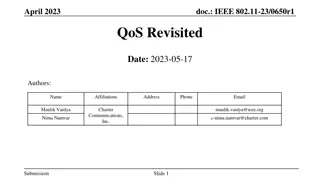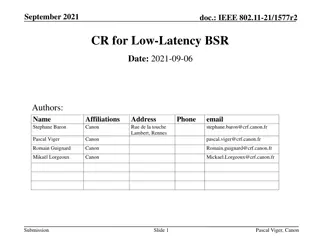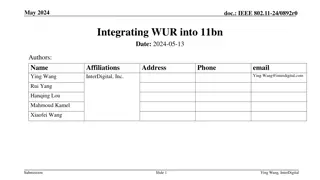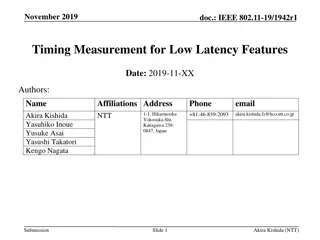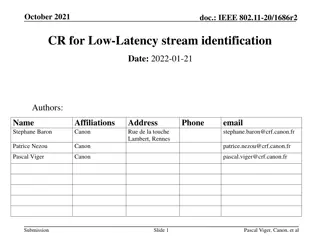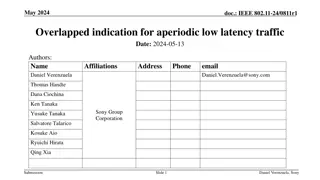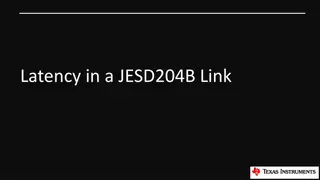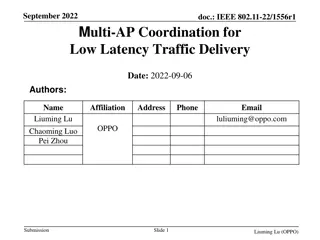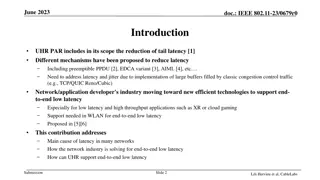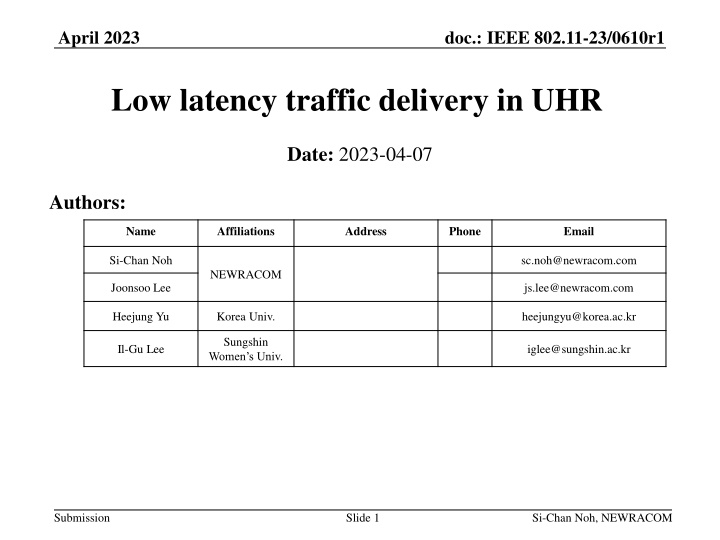
Low Latency Traffic Delivery in UHR Networks
Enhance the tail latency distribution and reduce jitter in UHR networks by addressing low latency traffic delivery challenges. Proposed approach involves using preamble puncturing to allocate channels effectively, supporting both LL and non-LL traffic without collisions or delays.
Download Presentation

Please find below an Image/Link to download the presentation.
The content on the website is provided AS IS for your information and personal use only. It may not be sold, licensed, or shared on other websites without obtaining consent from the author. If you encounter any issues during the download, it is possible that the publisher has removed the file from their server.
You are allowed to download the files provided on this website for personal or commercial use, subject to the condition that they are used lawfully. All files are the property of their respective owners.
The content on the website is provided AS IS for your information and personal use only. It may not be sold, licensed, or shared on other websites without obtaining consent from the author.
E N D
Presentation Transcript
April 2023 doc.: IEEE 802.11-23/0610r1 Low latency traffic delivery in UHR Date: 2023-04-07 Authors: Name Affiliations Address Phone Email Si-Chan Noh sc.noh@newracom.com NEWRACOM Joonsoo Lee js.lee@newracom.com Heejung Yu Korea Univ. heejungyu@korea.ac.kr Sungshin Women s Univ. Il-Gu Lee iglee@sungshin.ac.kr Submission Slide 1 Si-Chan Noh, NEWRACOM
April 2023 doc.: IEEE 802.11-23/0610r1 Introduction Improving the tail of the latency distribution and jitter is one of the main requirement in the UHR group as described in the approved PAR[1] There are many latency improvement contributions as follows: Preemption [2], [3] Multi-AP Operation for low latency (LL) traffic [4], [5] AI/ML [6] In this presentation, we discuss a basic transmission approach allow LL traffic in perspective of flexible punctured channel information considering puncturing scheme in 11ax and 11be Submission Slide 2 Si-Chan Noh, NEWRACOM
April 2023 doc.: IEEE 802.11-23/0610r1 Problem statement How to deal with LL traffic in 802.11 networks without collision/interference and no waiting in the middle of the TXOP of the other client? In case of dedicated scheduling which is assigns resource without the contention between LL and non-LL traffic, the following conditions might be needed: assign resource in terms of certain condition indicate information about the assigned resource Submission Slide 3 Si-Chan Noh, NEWRACOM
April 2023 doc.: IEEE 802.11-23/0610r1 Approach : Using preamble puncturing An AP can indicate the channels as punctured or non-punctured within its operating bandwidth Load LL traffic into punctured channel could be one of candidates to support LL traffic It means, assign deterministic punctured channel for an event- based LL traffic, we can prevent collision of on-going non-LL traffic transmission Non-Punctured Non-LL traffic Non-Punctured Non-LL traffic Punctured LL traffic Non-Punctured Non-LL traffic Submission Slide 4 Si-Chan Noh, NEWRACOM
April 2023 doc.: IEEE 802.11-23/0610r1 Summary It is challenging to deal with LL traffic in 802.11 networks without collision/interference and no waiting in the middle of the TXOP of the other client We propose a basic approach allow LL traffic in perspective of flexible punctured channel information considering puncturing scheme in 11ax and 11be Submission Slide 5 Si-Chan Noh, NEWRACOM
April 2023 doc.: IEEE 802.11-23/0610r1 Reference [1] 23/0480r0, UHR Proposed PAR [2] 23/0018r1, Low Latency Support in UHR [3] 23/0092r0, Preemption for Low Latency Application [4] 22/1899r0, Multi-AP Operation for Low Latency Traffic Delivery Follow up [5] 22/1556r0, Multi-AP Coordination for Low Latency Traffic Delivery [6] 22/1519r0, Requirements of Low Latency in UHR Submission Slide 6 Si-Chan Noh, NEWRACOM

